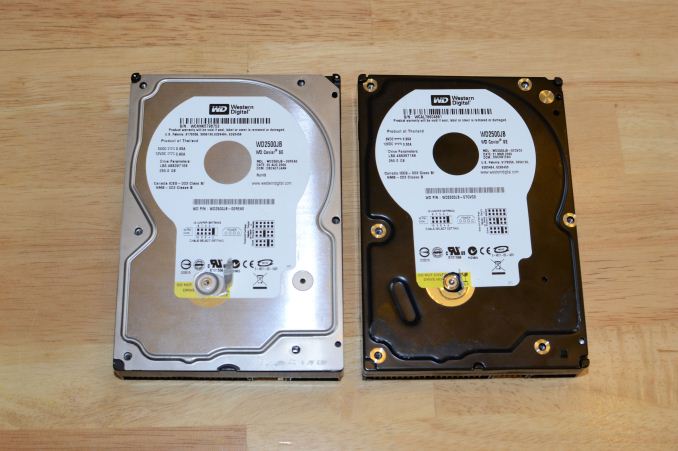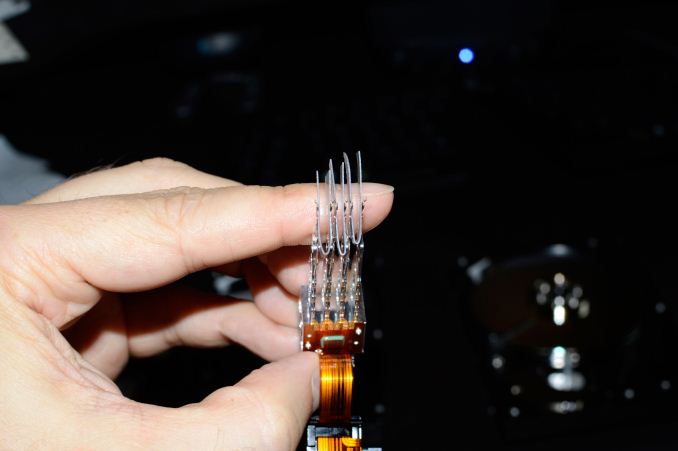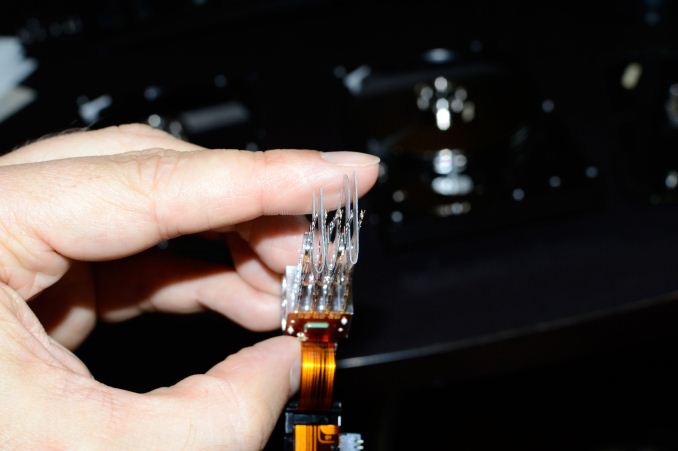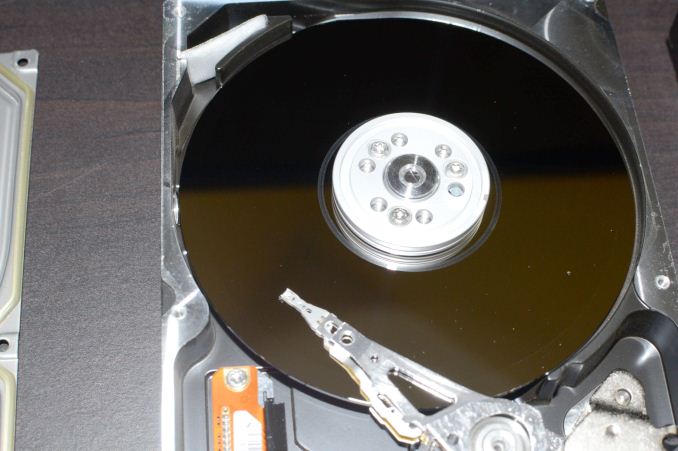Best Way to Read Hard Drive if the Heads Are Not Working
Earlier this twelvemonth, I posted a curt story and video of my effort at – and success – repairing a Gateway notebook that was suffering a Code 43 GPU error. The "fix" seemed well-nigh too good to be truthful: dismantle the notebook and nail the GPU with a hairdryer for a couple minutes in club to reflow the solder. At the fourth dimension, I likewise mentioned that I had a couple hard drives that I was going to try repairing in lodge to recover some pictures and data for a friend. Vi months later, apparently a few people still desire to know what happened, so this is my story. Sadly, things didn't go so well this fourth dimension, but let me get through the total sequence of events. (I thought nigh sweeping this one under the carpeting, but maybe some of you can learn from my experience.)
First, most tech savvy people have probable heard of the diverse tricks you can utilise to endeavor to get data off of a failing difficult drive. Put it in the freezer, knock it on the side, drop information technology, cede a virgin keyboard under the pale LED calorie-free…. Some of those tricks might actually work on occasion, but I'm hither to tell you than none of them – no, not fifty-fifty the keyboard sacrifice! – have worked for me in my lifetime of geekdom. Just there'south one option that I accept heard can work: the difficult drive transplant.
I actually accept a blood brother who successfully recovered the information off of a failed laptop drive using a transplant maybe six or vii years back. The idea is pretty simple to grasp: when a hd fails, there are various components that tin can go bad, including the ability delivery organization, the circuit board, the motor/bearings, and/or the drive heads. In his instance, my recollection is that either the drive heads or the motor (or both) was at error. So, you lot become out and purchase a working bulldoze that's as close to identical to your failed bulldoze as possible, so swap some of the working pieces into the failed drive and presto: you accept your data back. In my brother'due south instance, he got the pictures and data he was later, but he noted that the "stock-still" bulldoze was super wearisome – like transfer speeds of around ii-5MB/s when 20-50MB/s should have been possible. After copying the data off to another difficult drive, he tossed both the donor drive and the "sort of working" drive in the trash and chosen himself lucky. So, information technology can work, merely it'southward by no means guaranteed.
Round 1: Fight!
Fast forward to my latest attempts at fixing a crashed difficult drive, this time from my dear old dad. He has a bunch of photos that were stored on an external HDD, a 250GB Western Digital IDE drive from seven years ago. I confirmed the drive was dead – it spins up, clicks, sounds like it powers off for a separate second, then tries again. Lather, rinse, repeat, but the bulldoze is never recognized past the OS when connected via USB, or by the BIOS when connected directly via IDE. I went on eBay and looked up the drive model, plant a potential donor drive, and ordered information technology. I was rash and a little too confident, unfortunately, and when the donor drive arrived I realized I hadn't done my due diligence:

I had a new Western Digital WD2500JB Caviar SE, just this model had different firmware, a different PCB, and a silver case instead of black, and a manufacturing date that was 5 months later than the expressionless bulldoze. Only, the donor drive worked – I confirmed this in both the USB enclosure besides as with a directly IDE connexion – so I decided to endeavor doing a transplant. Here'due south where things got really impaired on my part.
First, I should have tried swapping the system boards; if that didn't work on the new drive, I would at least know that the firmware was incompatible. That wouldn't put the kibosh on the transplant idea, though, equally the drive heads might be compatible. Anyhow, I threw caution to the wind, opened the failed drive, opened the donor, pulled everything apart – while snapping pictures of the procedure – and then got it all dorsum together again. I tried to be careful, but in retrospect I was really foolhardy with my approach. Not surprisingly, the transplant failed – I tried swapping platters from the dead bulldoze to the working bulldoze, swapping bulldoze heads, swapping circuit boards – basically all of the possible combinations, just non in the most logical lodge of progression. After the failed drive continued to emit the "click of death", I reassembled the donor drive and found that it too was now dead and clicking. Oops.
Round 2: Apply Your Head
For my next attempt, I did more research. I figured I needed to get the exact same firmware revision, and finding someone that was selling the correct bulldoze took quite a flake more time. Eventually, I did get a second drive, and later my first feel I was a little agape to try once more. I did more research, got some ideas, and finally tried again – only without so much blowing.
This fourth dimension, I checked that the donor drive really worked (it did), and and then I started by swapping circuit boards. With the donor drive, I could use either circuit board and it was still fine, so at least on that level the 2 drives were uniform. Side by side, it was time to endeavour swapping some other part to see if I could set up the failed drive. Given what I just said about circuit board swapping, that was my first attempt, and not surprisingly the original bulldoze connected to emit a click of expiry on ability up. About probable it has crashed bulldoze heads, and so that was the logical next item to swap.
Having discovered that the removal and replacement of three platters tin be tricky at best, I wanted to avoid doing that again, and so I only needed to remove the drive head assembly from the donor and put information technology in the original drive. This is easier said than washed. Ane matter I read is that the drive heads are extremely fragile, and if they touch each other they'll unremarkably exist cleaved in the process. To forbid this, yous need to put a picayune shim in between each gear up of heads and then that when you move the actuator off the platters, the bulldoze heads don't snap together. I created iii shims, got them into place, pried apart the strong (VERY strong!) magnets that help the actuator position correctly during operation, and carefully removed the head associates. Except…I screwed up again!
A few other pieces of advice are in social club at this point. First, I read that you don't want to move the drive heads/actuator unless the platters are spinning in the proper direction – basically, reduce friction on the bulldoze heads. I did my best to make certain the platters were rotating, though it's possible this screwed up the donor head associates before I got any further. 2d, to get the head assembly out, on the WD drives you lot need to remove ii screws that hold the meridian magnet in place, then pry the magnet autonomously (I used a apartment head screwdriver), and so you as well need to remove the picayune drive park stopper that has a smaller magnet that keeps the heads parked when the drive is powered off. Getting the magnets apart and removing the little plastic piece is a bit catchy, and then once again I may take damaged the heads at this stage.
Finally, I talked almost the shims, and I want to make special notation of the fact that the more than platters you take, the more than difficult it's going to be to become all the shims properly installed. You'll probably make some slight scratches if yous're using homemade shims like me, just I don't know if that's enough to fully kill the performance (more on this beneath). With the elevation magnet removed and the shims in place, if all goes well you can move the heads off the platters and they won't touch on, and and then you can remove the caput assembly. It should wait similar this:

But remember how I said I screwed up? Well, I had the three shims in place I idea, but information technology turns out I missed on the middle platter so those heads continued. Uh oh. And so instead of the higher up issue this is what I had:

I put the shim in the proper position, but at this point I feared for the worst. Afterward putting the heads into the patient drive, my fears were confirmed: more than clicking to death. Except, the clicking wasn't quite every bit bad, so perhaps only those middle heads are dead? Regardless, the BIOS/Bone nevertheless won't recognize the bulldoze and then the data is still lost. I as well swapped the hardware back into the original donor drive and confirmed that it'southward no longer working, so sure enough the bulldoze heads are at present dead. That'southward my failed HDD transplant attempt #2.
Round 3: 1 More Try
With the previous failures under my chugalug, you'd hopefully call back that I'd larn my lesson and move on – clearly transplanting difficult drive parts isn't my specialty. However, I have a friend that likewise contacted me with their ain drive, and I figured I would give information technology one more than go. This time the failed drive is a Maxtor DiamondMax Plus ix 80GB IDE drive from tardily 2004, merely despite the age there's a potential reward. Where the WD2500JB has three ~83GB platters, the Maxtor has a single 80GB platter, so the transplant should be easier. I in one case more sourced a drive from eBay with the same firmware, and I confirmed the bulldoze was working (note the "was"). I also swapped PCBs every bit my first examination for compatibility and that worked fine – I formatted the drive and copied over 5GB of data, consisting mostly of larger files, and measured a transfer charge per unit of around 15MB/s. How did nosotros ever live with such performance?
This time, I wanted to debunk i of the oft stated rumors of the difficult drive repair "professionals": don't open up the drive, considering as soon as you do your data is as good as gone! And don't forget the one well-nigh needing an ISO Class 5 make clean room. Such claims seem a scrap much, designed to get people to pay a thousand dollars to retrieve their data. Keep in mind that I'm not trying to get the drive in a permanently working condition; I only want to get it to read data for the 60 minutes or and so it might require for me to copy off important files, and and then the bulldoze can hit the trash bin for all I care.
So my first pace this time after doing a PCB swap (which didn't fix the cleaved drive) was to open the Maxtor drive, carefully motility the bulldoze heads to the edge of the platter (while rotating the disks), and then insert my piffling shim. Then I pulled the drive heads off the drive (removing the top part of the magnet), and at this point I basically had the heads complimentary and clear. Supposedly doing whatsoever of this is plenty to kill the donor bulldoze, right? After doing this, I reversed the process: put the heads back on, replace the magnet, remove the shim, return the heads to the "parked" position, close the bulldoze back up, and connect it to my PC. A short fourth dimension later and the drive is still working, at total speed fifty-fifty. Whew! Perchance in that location are some bad sectors at the border of the deejay, but at least with some impromptu testing that didn't appear to exist the example.
Having successfully moved the drive heads around and used my shim without killing the drive, it was now fourth dimension to try a head transplant. I opened the donor over again, opened the patient up, and guess what I establish? The failed drive appears to take a ring scratched into the platter where the drive heads park. Ouch! And so the heads accept definitely crashed, and crashed hard – and what'due south more, the scratched surface might be enough to brand any transplant fail equally well (as the working heads would be subject to the scratched surface as soon as you ability it up). But, information technology's still worth a endeavour.

Removing the head assembly in the Maxtor is a slightly different process than on the Western Digital drives. The cover comes off the aforementioned style, but there are no screws holding the magnet in place; yous just need to pry them apart. The caput associates on the other mitt has two screws property a smaller PCB in identify, with a 3rd larger screw on the pin point of the actuator. Getting that last screw off while keeping the 2 drive heads "safe" is a bit trickier than on the Western Digital, every bit the powerful magnets can cause pieces to shift unexpectedly.
Sadly, in the process of trying to get the head assembly disconnected and out of the donor drive, I screwed upward again and my little shim came out of its place, resulting in the 2 drive heads touching. My understanding is that the drive heads are very fragile, and I suspect there's likewise an element of magnetism or something involved that can get thrown off if the heads touch. Whatever the case, after the heads touched I suspected that the resulting transplant would fail again, and I was correct.
Three strikes and I'one thousand out. I now accept the original two dead drives and three others at present added to my collection. Thankfully, my full cost other than fourth dimension invested is at this bespeak pretty small-scale: $100 for the 3 replacement drives, and roughly 10 hours of research and piece of work on taking the drives apart and putting them back together. I've also tried a few combinations of hardware, but all signs indicate that I've damaged the drive heads on all three donors, and one time damaged there'south no easy set. Rather than investing more time and money, at this point I'm taking a break from the repairs and looking for other options.
Happily Never Later?
Sadly, the Western Digital WD2500JB from my dad remains dead, every bit does the Maxtor MiamondMax Plus ix. At this point, I'm not sure if I want to endeavor finding additional donors to try again, specially with the Maxtor where the platters at the center look scratched. I've messed around enough that peradventure the information is at this point unrecoverable except with specialized tools. There are some tools that could help, though – like a drive head replacement tool that does the job of my ghetto shim, and does it better. Sadly, the only places I can find seem to sell them every bit a kit with anywhere from 20 to 100+ tools for diverse bulldoze types. Obviously, most individuals simply care about one tool, but finding someone that will sell a single – even for $5 – is difficult. If you actually wanted to go whole hog, there are kits that have customized tools for removing the magnets, covers, etc. that run nearly $250, give or take. They would certainly aid, particularly if you were to do this frequently, simply for a unmarried drive repair it would be a flake much.
The alternative of course is to try a information recovery visitor. My requirements for any recovery agency are that the cost is reasonable – $300 would exist good, less is better, but up to $600 is at least worth considering. More chiefly, in that location should be no charge unless data is successfully recovered. There are a ton of places that will endeavour information recovery, but many charge exorbitant prices (sometimes more than $2000!) and most of them won't even guarantee that they'll be successful. I don't need a guarantee of success, but there's no fashion I'd pay $1000 or even $100 for a failure.
Just think about this: I tried three times, and while I don't have any special tools there was at least a run a risk of success. I've dismantled and put together many a PC and laptop in my day, and I've just truly killed a few pieces of hardware by error (like the fourth dimension I accidentally dropped a screw on the motherboard of a running PC and information technology managed to land in just the right place to short a few contacts and fry the board and CPU). Imagine if I started a data recovery visitor and charged even a partial $100 + hardware fee for failures! I could spend 1 60 minutes trying a transplant, and if it doesn't work I tin can transport both the original drive and the failed donor drive back to the customer (as proof of effort) and pocket the $100 in fees, and maybe fifty-fifty charge a markup on the donor drive. Frankly, that would be absurd, merely in that location are almost certainly companies that do exactly that. I'd go then far as to say paying for the failed donor drive(s) is even besides much – if a visitor says they can recover my data, then they either succeed or they get nothing, sort of like working as a lawyer with a contingent fee: you but pay if they "win" your case. That at least gives them more incentive to do the work properly.
Then we have the FUD (Fear, Dubiety, and Dubiousness) that the information recovery websites similar to spread around to deter others from trying. Finding reputable sites that actually attempt a transplant and document the procedure is like finding the proverbial needle in the haystack, which is a big reason for why I'one thousand writing this article. I personally know of at least 2 cases of people trying a drive transplant that worked enough for them to copy off their pictures and other important files; other than my higher up attempts, I don't actually know of any outright failures – most people just give up and throw the expressionless drive in the garbage, as the $1000+ fees are more they're willing to pay.
I thing that I can corroborate is that doing a transplant on a hard bulldoze is not something "simple", and doing it without the proper tools might be a waste of fourth dimension and money (and potentially render your data unrecoverable). Others might be better than I am and non make mistakes, but if I had some other donor drive around I think I've learned enough at this point that I could be successful (bold success is even possible). ISO certified Make clean rooms are probable unnecessary for near people doing a single transplant, but at the same time your operating area should at least exist clean. Even with my failures, I don't believe for a infinitesimal some of the hyperbole thrown effectually about how this sort of thing should merely exist attempted past professionals. Only get the proper tools starting time, and be very careful, and I remember in that location's a decent chance you lot can do the transplant on your own. Or else fork over the hundreds of dollars to a specialist and hope for the all-time.
Of course, a far better solution is to set things up and so that information recovery services aren't even required. There are enough of online backup services bachelor, including iDrive, Mozy, SugarSync, and even DropBox. The problem is getting enough free storage to handle everything you need. I personally have over 200GB of documents, pictures, and videos that I would be lamentable to lose, which means if I wanted a unmarried online backup utility I'd exist looking at $80 per year or more. If I merely want all my Word and Excel documents, though, it'due south not that bad: less than 200MB full for all of those! But nigh people really don't want to lose their digital photos, and as you can run across that's the lion'south share of the data I'd want to save (most thirty,000 images totaling over 100GB). Local fill-in is of course a lot easier, and outside of the cost of a drive it's "complimentary", but that doesn't protect you from fires, theft, or other disasters, so you lot demand to decide how important your information really is.
Wrapping this up, I don't know for certain if it's even possible to recover the data from these two drives at this indicate, but if anyone out at that place wants to give fixing either or both drives a go, ship me an email. I might see about purchasing the tools to help practice the transplant procedure at some point, only I'd want a skilful success charge per unit before I'd consider that a worthwhile investment. (Then I could try doing the service for friends, family, etc. and recoup my costs.) But for now I'm done; like I said, if yous recall you can go the information off of either drive, feel free to contact me. At this point I have picayune to lose, and if you lot succeed (with reasonable pricing), I'd love to have some place I could directly our readers likewise as friends/family unit/etc. who need such a service. On a similar annotation, if yous take had personal success (or failure!) with a difficult drive transplant, let us know in the comments; I'one thousand sure I'm not the merely one to have tried this, and it would be interesting to come across how many have succeeded/failed, also as get whatsoever other tips on how to go on.
Best Way to Read Hard Drive if the Heads Are Not Working
Source: https://www.anandtech.com/show/7330/hardware-tricks-how-to-not-fix-a-crashed-hard-drive